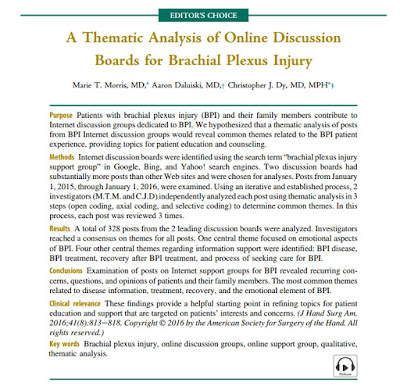Participating in the JHS Twitter Journal Club: "#JHSJC"
Want to participate in the new Journal of Hand Surgery journal club on Twitter, but need some help?. This resource was provided by the Eastern Association for the Surgery of Trauma on the website for their journal club, #EASTjc. I have made some slight modifications to match JHS and our #JHSJC. This is complementary to the guide already listed on the JHS Focus website.
---
Participate in the JHS Twitter Journal Club, #JHSJC. JHS moderators will regularly join authors of current articles of interest to all hand surgeons for an informal discussion on Twitter of the articles’ specifics and of related topics. These “Twitter chats” are open to the public, allow authors to discuss their advances with an interesting and diverse audience, and increase understanding and awareness of current studies among hand surgeons, hand therapists, plastic surgeons, orthopaedic surgeons, and other healthcare providers.
To prepare for the next #JHSJC chat, follow JHS editor-in-chief @BGTalkinMan and moderators @congenitalhand; @megancontimica, @rayravenMD, @robinkamalmd, @ChrisDyMD on Twitter.
Need more info on how to participate? Read on.
Getting Started with Twitter
Dr. Heather Logghe has posted an excellent introduction to the service, including signing up and creating your profile. Go to “Twitter 101: How to Set Up a Professional Twitter Account” for information.
Dr. Heather Logghe has posted an excellent introduction to the service, including signing up and creating your profile. Go to “Twitter 101: How to Set Up a Professional Twitter Account” for information.
Once you’ve signed up, learning to use the service isn’t hard. The University of Utah Health Sciences has developed an easy-to-read handout (PDF format), “Twitter 101: Understanding & Navigating Twitter” that describes @s, #s, replies, DMs, & RTs and other basics for health care professionals getting started on Twitter.
Joining a Twitter Chat
“Hashtags” like #JHSJC allow many people to easily talk about a single subject without the “reply-to-a-reply-to-a-reply” chains seen in email or in small Twitter conversations. A group of people can use the same hashtag to create a “tweetchat” that can then be easily followed, searched, and archived. To participate in the JHS Twitter Journal Club discussion, just include “#JHSJC” in your tweet; following the ongoing discussion is as easy as tapping or clicking on the #JHSJC hashtag or searching for it on the web or on your device’s Twitter app. More tips and tricks for participating in a Twitter chat are available in the SocialTimes article, “Advanced Twitter Tip: How to Join a Twitter Hashtag Chat”.
Following the #JHSJC chat
“Hashtags” like #JHSJC allow many people to easily talk about a single subject without the “reply-to-a-reply-to-a-reply” chains seen in email or in small Twitter conversations. A group of people can use the same hashtag to create a “tweetchat” that can then be easily followed, searched, and archived. To participate in the JHS Twitter Journal Club discussion, just include “#JHSJC” in your tweet; following the ongoing discussion is as easy as tapping or clicking on the #JHSJC hashtag or searching for it on the web or on your device’s Twitter app. More tips and tricks for participating in a Twitter chat are available in the SocialTimes article, “Advanced Twitter Tip: How to Join a Twitter Hashtag Chat”.
Following the #JHSJC chat
·
Option 1 (highly recommended): Visit tchat.io and enter the hashtag #JHSJC to
follow the conversation in real-time. The site will automatically add the
#JHSJC hashtag to each of your tweets and make it easier for you to
participate. An alternative to tchat.io is tweetchat.com. Be sure to allow
access your Twitter account.







